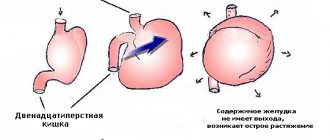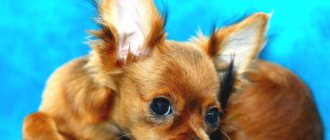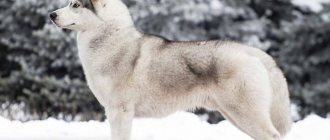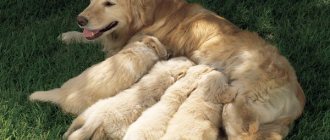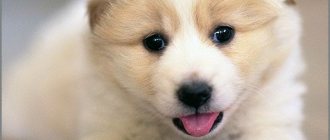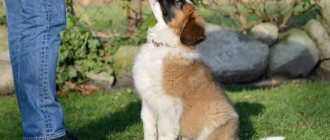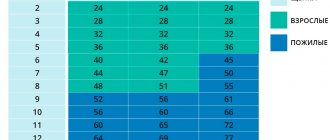Main types of bite
The jaws of dogs of different breeds may be positioned differently in relation to each other. The types of bites in dogs are as follows:
- scissor-shaped (normal);
- pincer-shaped (straight);
- undershot;
- snack (bulldog-shaped).
The bite of such pets depends primarily on the structure of their jaws. The latter can have different lengths and development.
Sometimes a dog's jaws can be distorted. Also, the position of the teeth has a great influence on the bite. Sometimes it happens that the dog’s jaws themselves are fine, but the teeth grow incorrectly.
Scissor bite
Representatives of the canid genus are known to belong to the group of predators. In the wild, such animals hunt other animals in order to feed themselves. Therefore, the structure of the jaws of canids, including dogs, is designed primarily to grab and hold prey. In this regard, the most physiological is the scissor bite.
This jaw structure is considered normal for most dog breeds. Animals with such a bite have much less wear and pain in their teeth. This structure is considered the norm, for example, for Caucasian and German shepherds, terriers, pinschers, and Dobermans. That is, the correct bite in dogs of most breeds is a scissor bite.
In this case, dogs’ jaws are developed harmoniously. The front surface of the lower incisors is tightly adjacent to the back surface of the upper ones. The canines of dogs with this type of bite meet in a “lock.” In this case, the lower incisors rest against the base of the upper ones. Photos of the bite in dogs of this variety can be seen above.
Pincer bite
This jaw position is considered unacceptable for most dog breeds. However, a pincer bite is still considered a not too serious defect. In this case, the dog’s lower and upper incisors are located on the same line and rest against each other. Because of this, they wear down very quickly. A direct bite in dogs usually does not have a negative effect on canines and molars.
Pincer-like closure of the incisors in dogs can be either congenital or acquired. Such a defect can develop, for example, due to the puppy playing tug too actively. Excessive loads of this kind, of course, are unlikely to have a negative impact on the jaw. However, a puppy's lower incisors may begin to move forward when pulled.
Consequences
The chewing apparatus belongs to the gastrointestinal tract and is considered its beginning. Therefore, any deformations of the teeth and jaws negatively affect the digestive processes and have the following manifestations:
- Eating food may be difficult, the dog cannot chew it fully, which provokes gastrointestinal disorders;
- with severe malocclusion, there is a risk of injury to the oral cavity;
- When the jaws are not closed tightly, the dog constantly drools, which causes weeping eczema and other dermatological diseases.
If the animal exhibits small deviations from the norm, and they do not affect the quality of life, then the bite may not be corrected. But usually the decision on the need for correction is made by a veterinarian - an orthodontist.
Underbite
This defect is considered more serious than a pincer bite. Underbite causes disqualification at shows of most dog breeds. The lower jaw in animals in this case is underdeveloped. Because of this, the dog has free space between the incisors. The lower canines are loosely adjacent to the edges of the upper jaw.
This type of defect can lead to the development of serious dental diseases in pets. The most affected dogs with this type of bite are the canines and molars. In this case, they are adjacent to each other too tightly. Also, dogs with this problem often develop tartar.
Features of the structure of the Yorkie's jaw
By the end of the development of the skull, the Yorkie should have 42 teeth: 20 in the upper jaw, 22 in the lower. Yorkie teeth classification:
- incisors;
- fangs;
- premolars;
- molars.
If a dog is missing at least 1 tooth, you can forget about a show career. A professional judge cannot give preference to a dog with an incomplete set.
Snack
This problem is most often encountered by owners of dogs with shortened jaws. For some breeds, such a bite is considered normal. For example, undertaking in bulldogs, bull terriers, and Pekingese is not considered a defect.
In this case, the dog's lower incisors protrude in front of the upper ones. The lower jaw of the animal protrudes forward. With such a defect, the dog’s canines and incisors may even be exposed. This type of bite is especially common in bulldogs. Probably many people have seen dogs of this breed with a far protruding lower jaw. This is why this type of bite is often called a bulldog bite.
What other defects are found?
In addition to those described above, dogs may experience other types of malocclusions. For example, a fairly common occurrence in such pets is misalignment of the jaws. In this case, a void may form on one edge between the dog’s incisors. Veterinarians call this defect asymmetry. Of course, this arrangement of the jaws can also cause the development of various kinds of diseases in a pet.
Sometimes, as already mentioned, a malocclusion in a dog can be associated with defects in the location of the teeth. A fairly common pathology in purebred dogs is retroposition. In this case, for example, the canines on the dog's lower jaw may be shifted to the center. This defect is quite common in Yorkshire terriers.
general information
In dentistry, types of occlusion refer to the position of the teeth in the mouth when the jaws meet. This contact is called occlusion. Central occlusion is when the teeth meet at most points, the head of the mandible is at the base of the articular tubercle, and the middle of the face should correspond to the passing line between the main incisors.
Normal (physiological) types of occlusion include:
- straight;
- orthognathic;
- biprognathic;
- progenic.
Each of them has its own characteristics. Violations can be determined at home. An exemplary closure is considered to be the option when the upper row of teeth overlaps the lower ones by no more than a third. The contact itself is tight. In addition, the shape and size of the teeth are taken into account. The upper jaw is characterized by a slight inclination towards the lips, and the lower jaw - towards the tongue.
Causes of malocclusion
In ordinary yard dogs, jaw defects are relatively rare. Malocclusion in most cases is a genetic disease. And therefore, owners of purebred dogs most often face this problem. It was noted that in most cases such a defect occurs in small dogs.
Breeders, of course, always make sure that their wards only produce puppies that meet the breed standards. And therefore, when choosing manufacturers, the applicants’ teeth are always examined. The bite of dogs selected for breeding must fully comply with breed standards. Animals with incorrect jaw position are never allowed to be bred.
In addition to genetic failures, the reasons for the development of such a defect may be:
- lack of minerals in the diet of a pregnant bitch and puppies;
- jaw injuries at a young age;
- too active games with a lot of stress on the jaws.
Sometimes malocclusion in dogs also becomes a consequence of problematic replacement of baby teeth (too firmly seated or very large).
Bite in dogs: types
Main types of bite
The jaws of dogs of different breeds may be positioned differently in relation to each other. The types of bites in dogs are as follows:
- scissor-shaped (normal);
- pincer-shaped (straight);
- undershot;
- snack (bulldog-shaped).
The bite of such pets depends primarily on the structure of their jaws. The latter can have different lengths and development.
Sometimes a dog's jaws can be distorted. Also, the position of the teeth has a great influence on the bite. Sometimes it happens that the dog’s jaws themselves are fine, but the teeth grow incorrectly.
Scissor bite
Representatives of the canid genus are known to belong to the group of predators. In the wild, such animals hunt other animals in order to feed themselves. Therefore, the structure of the jaws of canids, including dogs, is designed primarily to grab and hold prey. In this regard, the most physiological is the scissor bite.
This jaw structure is considered normal for most dog breeds. Animals with such a bite have much less wear and pain in their teeth. This structure is considered the norm, for example, for Caucasian and German shepherds, terriers, pinschers, and Dobermans. That is, the correct bite in dogs of most breeds is a scissor bite.
In this case, dogs’ jaws are developed harmoniously. The front surface of the lower incisors is tightly adjacent to the back surface of the upper ones. The canines of dogs with this type of bite meet in a “lock.” In this case, the lower incisors rest against the base of the upper ones. Photos of the bite in dogs of this variety can be seen above.
Pincer bite
This jaw position is considered unacceptable for most dog breeds. However, a pincer bite is still considered a not too serious defect.
In this case, the dog’s lower and upper incisors are located on the same line and rest against each other. Because of this, they wear down very quickly.
A direct bite in dogs usually does not have a negative effect on canines and molars.
Pincer-like closure of the incisors in dogs can be either congenital or acquired. Such a defect can develop, for example, due to the puppy playing tug too actively. Excessive loads of this kind, of course, are unlikely to have a negative impact on the jaw. However, a puppy's lower incisors may begin to move forward when pulled.
Underbite
This defect is considered more serious than a pincer bite. Underbite causes disqualification at shows of most dog breeds. The lower jaw in animals in this case is underdeveloped. Because of this, the dog has free space between the incisors. The lower fangs are loosely adjacent to the edges of the upper one.
This type of defect can lead to the development of serious dental diseases in pets. The most affected dogs with this type of bite are the canines and molars. In this case, they are adjacent to each other too tightly. Also, dogs with this problem often develop tartar.
Snack
This problem is most often encountered by owners of dogs with shortened jaws. For some breeds, such a bite is considered normal. For example, undertaking in bulldogs, bull terriers, and Pekingese is not considered a defect.
In this case, the dog's lower incisors protrude in front of the upper ones. The lower jaw of the animal protrudes forward. With such a defect, the dog’s canines and incisors may even be exposed. This type of bite is especially common in bulldogs. Probably many people have seen dogs of this breed with a far protruding lower jaw. This is why this type of bite is often called a bulldog bite.
What other defects are found?
In addition to those described above, dogs may experience other types of malocclusions. For example, a fairly common occurrence in such pets is misalignment of the jaws.
In this case, a void may form on one edge between the dog’s incisors. Veterinarians call this defect asymmetry.
Of course, this arrangement of the jaws can also cause the development of various kinds of diseases in a pet.
Sometimes, as already mentioned, a malocclusion in a dog can be associated with defects in the location of the teeth. A fairly common pathology in purebred dogs is retroposition. In this case, for example, the canines on the dog's lower jaw may be shifted to the center. This defect is quite common in Yorkshire terriers.
Causes of malocclusion
In ordinary yard dogs, jaw defects are relatively rare. Malocclusion in most cases is a genetic disease. And therefore, owners of purebred dogs most often face this problem. It was noted that in most cases such a defect occurs in small dogs.
Breeders, of course, always make sure that their wards only produce puppies that meet the breed standards.
And therefore, when choosing manufacturers, the applicants’ teeth are always examined. The bite of dogs selected for breeding must fully comply with breed standards.
Animals with incorrect jaw position are never allowed to be bred.
In addition to genetic failures, the reasons for the development of such a defect may be:
- lack of minerals in the diet of a pregnant bitch and puppies;
- jaw injuries at a young age;
- too active games with a lot of stress on the jaws.
Sometimes malocclusion in dogs also becomes a consequence of problematic replacement of baby teeth (too firmly seated or very large).
How to prevent the development of defects: feeding
In order not to encounter the problem of malocclusion in the future, the owners of the puppy immediately after purchasing it need to choose the most suitable and balanced diet for it. Ready-made pet food should be purchased of the highest quality.
At the same time, you also need to ensure that the composition of the “pads” corresponds to the age of the pet. Dogs kept on natural food must be given special vitamin and mineral supplements in their diet.
In this case, you should choose a specific type of such premix in accordance with the recommendations of the veterinarian.
Periodic inspections
To prevent the development of malocclusion in a pet, owners should also periodically check its oral cavity.
In particular, this procedure often needs to be performed during the change of the puppy’s milk teeth. If the owner discovers that they are interfering with the growth of permanent ones, the pet should be immediately taken to the veterinarian.
The specialist will remove the puppy’s baby tooth, and the permanent one will grow in the correct position.
For older puppies, the oral cavity is examined to identify abnormally growing teeth. Correcting a bite in young dogs is much easier than in adults. In order to achieve the correct position of the teeth, puppies usually simply wear a special rubber ring.
Fixes
Unfortunately, in most cases, it is quite rare to achieve a normal bite in a dog with incorrect position of the jaws or teeth. But of course, its owners can try to help such a pet.
There are only two ways to correct a bite in dogs:
- surgical;
- orthodontic.
Veterinarians use the first technique to correct the position of animals’ jaws. The second technology is used for dog teeth.
Using braces
Such orthodontic devices are used to correct bites in dogs quite often. The operating principle of this type of structure is extremely simple.
Braces press the dog's teeth into the correct position. The animal usually does not experience any particular discomfort. Under the pressure of braces, the dog's teeth gradually begin to shift.
In this case, the free space formed in the same place is filled with bone tissue.
In some cases, wearing braces for dogs may, of course, be contraindicated. Do not correct an animal’s bite in this way, for example, if they have problems such as:
- allergy;
- ulcerative stomatitis;
- gingivitis;
- formations in the oral cavity.
Dogs wearing braces must also have their teeth brushed. Therefore, pet owners who decide to correct their bite using such a design should begin to accustom them to such a procedure in advance.
Dentures for dogs
A pathological bite in a dog, as already mentioned, easily leads to various types of dental problems in the pet. It is often impossible to correct this defect. In this case, dogs' teeth wear down very quickly. And so that the animal does not have problems with the gastrointestinal tract, in this case it is possible to order prostheses for it.
The technology for performing a dental procedure is similar to the technique for installing crowns in humans. Such a procedure is, of course, expensive. But it also helps to maintain your pet’s health very effectively. Unlike people, dogs often have metal teeth inserted into them. After all, such crowns are cheaper than ceramic ones.
Currently, not all veterinary clinics provide dental installation services for dogs. But finding a specialist who has the skills to install crowns on animals in our time will not be difficult, including in Russia.
.ru
Source: https://vk.com/@cynologylife-pricus
How to prevent the development of defects: feeding
In order not to encounter the problem of malocclusion in the future, the owners of the puppy immediately after purchasing it need to choose the most suitable and balanced diet for it. Ready-made pet food should be purchased of the highest quality. At the same time, you also need to ensure that the composition of the “pads” corresponds to the age of the pet. Dogs kept on natural food must be given special vitamin and mineral supplements in their diet. In this case, you should choose a specific type of such premix in accordance with the recommendations of the veterinarian.
Care
During the period of teeth change, the puppy needs special care and attention. At least 2 - 3 times a week you need to examine the mouth of a small Yorkie and, if it turns out that the growth of the molars is hampered due to the milk teeth that have not yet fallen out, it is necessary to take measures to remove them. When playing with a puppy, you should not pull anything from his mouth: this can easily ruin his bite. It is also undesirable to let your puppy chew on hard objects, as it can damage or even break the tooth.
In order for a Yorkie to develop its jaw muscles, it is necessary to give it not soaked dry food, but solid food with anatomically shaped granules that clean the surface of the tooth and at the same time contribute to the proper development of the dog’s jaws. At the same time, during the change of teeth, it is better to feed the puppy food with a high content of calcium and phosphorus.
If your pet eats natural food, then it is necessary to add vitamin and mineral supplements to its food. If this is not done, then problems may begin not only with the correct growth of teeth, but also with the exterior in general. For example, ears may fall off and paws may become crooked. It is very useful for growing puppies, and even adult Yorkies, to chew on special toys, as well as peeled raw carrots or an apple.
If plaque does form on the teeth, it can be cleaned off using a toothbrush with a special dog paste applied to it. Human pastes and tooth powders cannot be used for these purposes: they can cause allergies or stomach problems.
In order to reduce the risk of problems with teeth and bite, you should not take puppies whose estimated weight is less than 2 kg.
And if the owner is interested in the exhibition or breeding career of his pet, then it is better for him to buy a dog after changing teeth. If you take a small puppy, then you need to see what kind of bite his parents have.
Periodic inspections
To prevent the development of malocclusion in a pet, owners should also periodically check its oral cavity. In particular, this procedure often needs to be performed during the change of the puppy’s milk teeth. If the owner discovers that they are interfering with the growth of permanent ones, the pet should be immediately taken to the veterinarian. The specialist will remove the puppy’s baby tooth, and the permanent one will grow in the correct position.
For older puppies, the oral cavity is examined to identify abnormally growing teeth. Correcting a bite in young dogs is much easier than in adults. In order to achieve the correct position of the teeth, puppies usually simply wear a special rubber ring.
Causes of malocclusions
The most common cause of malocclusion, unfortunately, cannot be eliminated. This is a hereditary factor. The only way to prevent its spread to offspring is to deprive genetically inferior animals of permission to breed.
In addition, this pathology can also be acquired. It is most often caused by insufficient care of the puppy. There are several such factors:
- Repeated heavy loads on the teeth of a young animal during active games of tug are very unhelpful for him. You need to carefully control the force with which the puppy pulls the coveted toy.
- The consequences of trauma and damage to the jaws when chewing bones and hard objects often lead to malocclusion.
- Violation of the timing of the loss of milk teeth leads to the fact that the growing molars, bumping into the missing milk teeth, change their direction of growth.
- Lack of calcium, vitamin D, and an unbalanced diet lead to rickets and gradually deform the bite.
- Abnormally short labial frenulums cause the teeth to be compressed, causing the bite to become pathological.
Fixes
Unfortunately, in most cases, it is quite rare to achieve a normal bite in a dog with incorrect position of the jaws or teeth. But of course, its owners can try to help such a pet.
There are only two ways to correct a bite in dogs:
- surgical;
- orthodontic.
Veterinarians use the first technique to correct the position of animals’ jaws. The second technology is used for dog teeth.
Using braces
Such orthodontic devices are used to correct bites in dogs quite often. The operating principle of this type of structure is extremely simple. Braces press the dog's teeth into the correct position. The animal usually does not experience any particular discomfort. Under the pressure of braces, the dog's teeth gradually begin to shift. In this case, the free space formed in the same place is filled with bone tissue.
In some cases, wearing braces for dogs may, of course, be contraindicated. Do not correct an animal’s bite in this way, for example, if they have problems such as:
- allergy;
- ulcerative stomatitis;
- gingivitis;
- formations in the oral cavity.
Dogs wearing braces must also have their teeth brushed. Therefore, pet owners who decide to correct their bite using such a design should begin to accustom them to such a procedure in advance.
How to correct an overbite
Incorrect bites in an animal can ruin its entire career if the animal is a breeding animal, raised for exhibitions and breeding. But for ordinary animals, such a defect also does not bring anything good: the onset of digestive problems, caries and other troubles can significantly complicate the life of both the animal and its owner.
Note that the optimal period for correcting the bite is the age of the animal from five months to a year. After one year of age, it will be too late to deal with the bite: the molars at this time are already fully formed. A veterinarian orthodontist knows how to correct a dog’s bite: it is this specialist who should be contacted if a problem arises. Next, let's look at the main ways to fix the problem.
So, malocclusions are corrected using methods similar to those for this problem in humans. Typically, devices such as braces, removable mouth guards and other orthopedic structures are used for this purpose.
Mouth guards
This fix method is one of the most advanced. Mouthguards, unlike braces, are made of soft transparent material and can be removed before the dog eats. This is a huge advantage of the design, since removing the mouth guards allows for unhindered hygiene of dog teeth.
The principle of operation of the mouth guards is as follows: by fitting tightly to the animal’s teeth, they exert pressure on them in exactly the direction in which it is necessary. Once every 2-3 months, the old mouthguard is replaced with a new one, taking into account the shift in the dog’s dentition. In this way, slowly but surely, the teeth move into their proper place and the position of the jaws takes on a normal shape. Please note that it is recommended to remove the mouthguards only for hygiene or eating: the rest of the time the animal must wear the devices. Only long-term wearing of mouthguards will correct the bite. From time to time the device must be washed and cleaned.
The disadvantage of this method is the expensive cost of the mouthguards, so often animal owners prefer to use rubber removable braces, which are much cheaper. However, removable braces (rubber ring) can only help a puppy: they are useless for an adult animal.
Braces
Most often, a dog is given braces to correct the position of its teeth. These devices are made of metal wire with pins, and they do not have a negative effect on chewing food. The device is made of titanium with nickel or steel. Braces are placed according to the size of the dog's jaws, and are regularly tightened as the bite is corrected.
This design, unlike the previous ones, is non-removable. Braces are placed on the animal's teeth and are not removed throughout the treatment. The device is attached to the animal’s teeth using a special insoluble glue.
In order for braces to have the proper effect, the dog owner will need to strictly follow all the orthodontist’s recommendations regarding wearing the braces. It is also important to prevent defects in braces and not to let the dog chew hard objects, bones, or furniture.
When wearing braces, it is very important to pay increased attention to your dog's oral hygiene. Wearing braces has a negative impact on the condition of the teeth: under the metal structure, the teeth very quickly become covered with stone and are also susceptible to carious destruction. Food often gets stuck between the wires of braces, which then becomes a breeding ground for microbes. Timely, regular brushing of teeth and mouth is important.
It is not recommended to install braces if the animal suffers from the following diseases:
- allergies;
- stomatitis;
- caries;
- periodontitis;
In addition, if there are tumors and other neoplasms, wearing braces on animals is also prohibited. That is why a thorough examination is required before installing this design.
If you notice an animal has problems with bite, do not panic - you need to show the animal to a specialist. Only a professional examination can identify the causes of the problem and direct the course of treatment in the right direction. If the dog does not have breeding value, then the owners usually do not correct a slight malocclusion: the dog can live quite happily with it, remaining a family favorite.
But if the incorrect position of the teeth overshadows the dog’s exhibition career, or negatively affects the digestion process, it is worth fighting for the dog’s future career and health. You should just take into account that correcting this problem is not a matter of one day: as a rule, wearing braces or aligners lasts for several months and requires regular visits to the orthodontist.
Attention! : If any veterinary clinic claims to treat malocclusion through a special massage, we can confidently say that this is nonsense and a marketing ploy. No massage can correct the bite - and competent specialists are aware of this. Be sure to find a competent specialist - only an experienced orthodontist can be trusted to correct your dog’s teeth.
Dentures for dogs
A pathological bite in a dog, as already mentioned, easily leads to various types of dental problems in the pet. It is often impossible to correct this defect. In this case, dogs' teeth wear down very quickly. And so that the animal does not have problems with the gastrointestinal tract, in this case it is possible to order prostheses for it.
The technology for performing a dental procedure is similar to the technique for installing crowns in humans. Such a procedure is, of course, expensive. But it also helps to maintain your pet’s health very effectively. Unlike people, dogs often have metal teeth inserted into them. After all, such crowns are cheaper than ceramic ones.
Currently, not all veterinary clinics provide dental installation services for dogs. But finding a specialist who has the skills to install crowns on animals in our time will not be difficult, including in Russia.
Changing teeth in a Yorkshire Terrier
Puppies are born completely toothless. By the 12-15th day of life, their first teeth begin to cut - first, as a rule, the canines, followed by the incisors and premolars.
How many baby teeth does a Yorkie dog have?
By one and a half to two months, baby teeth have completely erupted. Normally there should be 28 of them. The dental formula for the upper and lower jaws of a puppy is the same: 6 incisors, 2 canines, 6 premolars.
Important! Sometimes “extra” milk may grow or, conversely, their amount may be less than normal.
But even if there is a significant shortage of baby teeth, this does not mean that the set of permanent teeth will grow incomplete.
When do Yorkies change their baby teeth?
From the fourth month of life, the Yorkie's teeth fall out and they begin to be replaced with permanent ones. During this period, many owners notice that the puppy’s behavior has changed, the pet has become more nervous, irritable, and impulsive.
There is no need to scold him for this - the puppy is undergoing important changes in his body. Gums itch and hurt, immunity drops. The maturation stage begins - the most important stage for the future health of the dog.
Important! The puppy really needs calcium at this time. The diet should be changed, enriched with cottage cheese, and supplements with calcium glycerophosphate.
Small Yorkies sometimes have a hard time coping with tooth changes.
Delayed teeth change in Yorkies
A full set of permanent teeth should be fully formed by 7 months. However, shift delays are a fairly common problem.
There can be many reasons why a dog has dental problems: genetics, poor nutrition, problems with the thyroid gland, diseases and injuries that the puppy had to endure at an early age.
Not only is delay dangerous, but also improper growth. Sometimes a permanent tooth, instead of taking the place of the milk tooth, is forced to grow next to it, since the root of the milk tooth is delayed in resorption. In this case, the milk needs to be immediately removed, otherwise the puppy faces uneven teeth, malocclusion, damage to the gums and jaw, and injury to the tongue.
Warning signs to look out for:
- The teeth are positioned incorrectly, too close to each other, or the permanent one grows next to the missing milk one.
- Any redness of the gums, swelling, bleeding.
- Pain when eating, to the point of refusing to eat.
